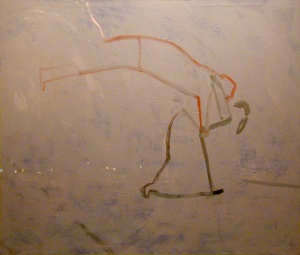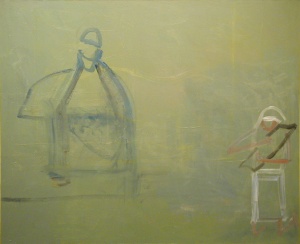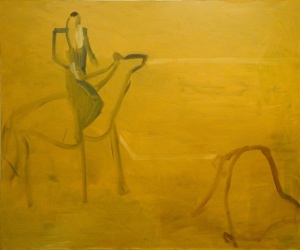Reflections of Biblical Texts by John Bradford
Form, content and meaning are the essential elements of every work of art. Form is the specific means and manner of expression a work of art assumes. Style and process are extensions of form. Content is the subject matter. The content may refer to a narrative, or a thing; i.e., a portrait, or a landscape. Or the content may be self-referential about the artwork itself or the process of its own creation. Meaning is what the viewer can appropriate from the work of art. The meaning may be found in the aesthetic experience of beauty or harmony, or it may be an intellectual, spiritual or emotional insight into some aspect of life. In truly masterful works these elements begin to become intertwined and indistinguishable from one another, essentially equivalents. The form not only expresses the content but ultimately becomes fused with the meaning. When this occurs the work of art approaches an ideal unity.
John Bradford’s Recent Works at 55 Mercer Street strives for exactly that unity. It is a unity idealized by High Modernism. Does he achieve it? Well, we know that only God can achieve unity in Achdus… nevertheless, each of us is commanded to strive to emulate God. Each work begins with a biblical text and then attempts to find a resonant reflection in color, line and gesture that unifies form, content and meaning. Bradford’s method is to paint alla prima (wet paint into wet paint) a hundred times over. He paints the entire composition in one work session. Whether it takes three or fourteen hours, he keeps on working. When he returns the next day to the painting, if he sees something that needs changing, he repaints the entire painting, redoing everything so that the primacy of alla prima is maintained. His work is subservient to the purity and the elemental nature of the biblical text. Over and over the painting evolves until a final resolution is achieved. Built upon dozens of paint layers, changes, reconsiderations and emendations, the final image is still the product of one finite work session.
Paradoxically, that simple image is visually dependent on its entire history reflected in the built up surface, layers of different colors and pentimenti or ghostly shapes appearing from previous incarnations. Much like reading a text for its literal meaning with the myriad commentaries on the adjoining page, his works are deceptively simple and yet intriguingly dense.
There are only six paintings in this exhibition, almost all over six by eight feet in dimension, and each is dominated by one color field where a minimal drawing delineates the figures and environment. The simplicity of the line verges on colored drawing if not for the sensitive integration of the line color with ground color. Just like the spare biblical text there are no facial features, delineated hands or feet, no descriptive settings. Only the narrative gesture survives Bradford’s ruthless pursuit of biblical verisimilitude and unity.

Jacob Wrestling with the Angel provides us with one the strongest images in the show. A red outlined figure is seen flying from the top of the canvas catching the stooped figure of Jacob as he trudges towards the right edge. The horizon is barely noted by a succession of white dots. They evoke spots of light, perhaps the sunrise, that also catches the angel’s upper leg still attached to the heavenly spheres. Jacob, bordered by a dark gray line, is oppressed and bent over but still striving onward as the verse says, “…but Israel, for you have striven with the Divine and with man and have overcome” (Gen. 32:29).This simple composition imagines the angel tackling our patriarch as he journeys toward the fateful meeting with his brother Esav. Bradford does more than just reflect the text.
He interprets it instructively telling us how this struggle with the Divine confronts us over and over again as we stride down life’s roadway. The struggle helps shape and define our personalities to better prepare us for the conflicts that await us. The spare form of the purplish gray ground defines the twilight just before the dawn. It is here that we metaphorically conduct our life until a red flash of Divine struggle interrupts our lives.

David Plays Saul the Harp also depicts a struggle, but this one is rooted in the mundane world of power politics, spiritual destiny and artistic power. “…The spirit of the Lord departed from Saul, and an evil spirit from the Lord frightened him.” Fearing that God’s favor would depart from him completely Saul became periodically melancholy and dreaded his downfall. He sought out a musician to soothe his agony that drove him mad with anxiety. David was brought to him and “David would take the harp, and would play with his hand, and Saul would be relieved, and it would be good for him, the spirit of evil would depart from him” (Samuel I 16:14-23). This was not only a developing struggle between David and Saul but also an examination of the role of art. In this case the music of David’s harp becomes an element of insight and control. The many times David plays his harp before the tortured Saul finally ends with Saul trying to kill David with his spear (Samuel I 19:10).
In Bradford’s painting the two figures are isolated and seem unable to affect one another against a pale green background. And yet we see undulating pentimenti of forms that connect them to each other. Saul’s body is disintegrating, blurred and indistinct, as a possible effect of the soothing music of David’s harp. Bradford subversively implies that art can have a corrosive and treacherous (but ultimately enlightening) effect on its audience.

Boaz and Ruth presents us with an entirely different prospect. Here art can reveal the heart of the narrative. We return to a wheat-yellow landscape that succinctly evokes Boaz inspecting his fields on a horse. Ruth is seen in the foreground, stooped and gleaning the leftovers from the harvest. Three quick pale white lines delineate the field that lies before her and the front profile of the horse. The only other significant white shape present is Boaz’s beard, the pe’ah of his face left unshorn. A careful reading of Bradford’s painting yields not just the meeting of Boaz and Ruth, but also the mitzvah of pe’ah. It is here in the subtlest of terms occupying the entire upper right quadrant of the canvas. The mitzvah presses down on her figure and blocks Boaz from a further incursion upon her. They are linked by the mitzvah that is an expression of the larger concept of tzedakah. This mitzvah is the crucial first step that will bring them together and will eventually result in the propagation of the Davidic line. In a way Bradford’s painting informs us that this simple mitzvah of leaving the corners of the fields for the poor doesn’t cure poverty, it only recognizes the importance of alleviating it. We must do what is just in this world and God will take care of the rest.
Boaz still sits astride his horse, confident as owner of the land. And Ruth is submissive as she collects what she must to feed Naomi and herself. Somehow, as long as a mitzvah intervenes into the struggles of life, the possibility of greatness and salvation survives. This complex Midrash is woven by the simple artistry of this painting.
The hiddushim or unique insights that these paintings present are the result of the extreme simplicity achieved in pursuit of a unity between form, content and meaning. In Bradford’s work Art meets the Torah in a rather astounding manner. His quest for purity produces a creative biblical exegesis embedded in a pure expression of High Modernism. Will these two audiences, the Jews and the modernists, appreciated what each has contributed?
John Bradford, Recent Works
55 Mercer Gallery, 55 Mercer Street, New York, N.Y.